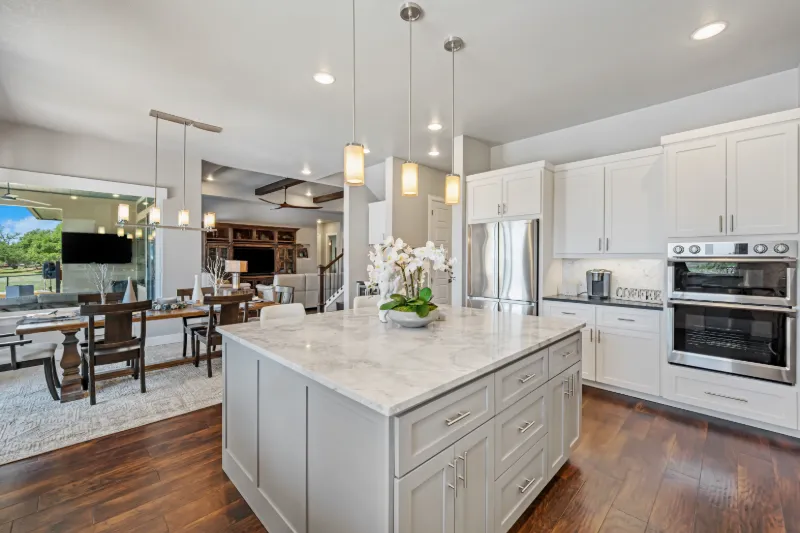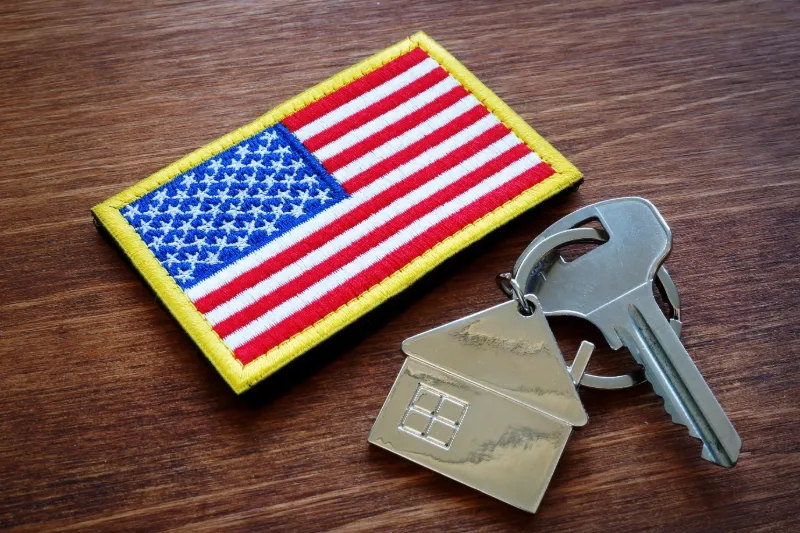When it comes to financing a home in Texas, I've seen many buyers struggle with…
Choosing Between a VA Loan vs a Conventional Loan in Texas
Embarking on the journey of buying a new home in Texas often begins with securing a suitable home loan. Among the array of types of loans available, VA home loans (designed for eligible veterans and active-duty military personnel) and conventional mortgages stand out as popular choices. Deciding which loan option aligns best with your financial goals and circumstances requires careful consideration of their unique features, benefits, and potential drawbacks.
Home Loans in Texas
The Lone Star State provides a dynamic and diverse real estate landscape, attracting homebuyers from across the nation. For those who have served in the military, VA loans offer a remarkable pathway to homeownership. For those seeking more traditional financing avenues, conventional mortgages present an attractive route.
In the following sections, we will explore the intricacies of these two popular home loan options, helping you navigate the path toward finding the perfect mortgage for your dream Texas home.
The Basics of Home Financing
Understanding the fundamentals of home financing in Texas is essential for making informed decisions about VA and conventional loans. Mortgage lenders, ranging from banks to credit unions, evaluate several factors when determining your eligibility for a loan.
The interest rate, a significant factor influencing your monthly mortgage payments, can vary based on market conditions and your financial profile. As you embark on your homebuying journey, it’s crucial to compare interest rate offers from multiple mortgage lenders.
Comprehending your credit score’s impact on loan terms, assessing your debt-to-income ratio, and securing a pre-approval are crucial steps in securing a mortgage that meets your financial needs and paves the way for a successful home purchase in Texas.
Key Factors Influencing Loan Choice in Texas
Several factors come into play when deciding between a VA and conventional loan in Texas. Your credit score is indeed important, as it significantly influences the interest rates and loan terms offered by lenders. A higher credit score often translates into more favorable loan conditions.
The desired loan amount also plays a crucial role. VA loans and conventional loans have different loan limits, and understanding these limitations helps determine the most suitable option for your financial needs. Additionally, evaluating your overall financial situation, including your down payment capabilities, DTI ratio, and long-term financial goals, assists in selecting the loan type best aligned with your circumstances.
VA Loans
Designed to express gratitude for the service and sacrifice of U.S. veterans and active-duty military personnel, VA Loans are backed by the Department of Veteran Affairs, offering a unique path to homeownership. These loans come with distinct advantages, including no down payment options, competitive interest rates, and a streamlined process for those who meet the eligibility criteria.
If you are a veteran or active military considering buying a home in Texas, understanding the benefits and requirements of VA Loans can significantly benefit your home buying journey.
What is a VA Loan?
A VA home loan, guaranteed by the Department of Veterans Affairs, presents an exceptional opportunity for eligible veterans, active-duty military personnel, and surviving spouses to achieve the dream of homeownership. Unlike conventional mortgages, VA loans typically require no down payment and often come with more lenient credit requirements.
The VA home loan program aims to make homeownership accessible to those who’ve served our country by mitigating financial barriers. It’s important to note that VA loans are subject to a funding fee, a percentage of the loan amount that helps offset the program’s cost. However, the funding fee can often be rolled into the loan, minimizing upfront expenses.
By working with a VA-approved lender, eligible borrowers can access competitive interest rates and navigate the home-buying process with expert guidance tailored to their unique needs.
Eligibility Criteria for VA Loans
To access the benefits of a VA loan, service members, veterans, and surviving spouses must meet specific eligibility requirements established by the Department of Veterans Affairs. Generally, these criteria revolve around the length and nature of military service.
Veterans need to provide a Certificate of Eligibility (COE) as proof of their service record, which includes information about the length and type of military service. Active-duty personnel can also obtain a COE after serving a certain duration.
Surviving spouses of veterans who died in the line of duty or as a result of a service-connected disability may also be eligible for a VA loan. Consulting with a VA-approved lender is essential to determine your eligibility based on your individual military background.
Exploring Conventional Loans
Conventional loans, a cornerstone of the mortgage market, provide a widely accessible pathway to homeownership for those who might not qualify for or choose not to use VA loan benefits. Understanding the nuances of conventional loans empowers borrowers to explore a range of financing options, interest rates, and loan terms tailored to their financial circumstances.
Conventional Loan Basics
A conventional mortgage refers to a home loan not insured or guaranteed by the federal government. These loans comprise a significant portion of the mortgage market and offer potential homebuyers a well-established financing option.
Conventional mortgages typically attract borrowers with sound credit histories and down payment capabilities. Lenders often offer competitive interest rates and diverse loan terms to attract borrowers seeking conventional financing. Choosing a conventional mortgage can offer financial flexibility, as they cater to various property types, including primary residences, second homes, and investment properties.
Navigating the complexities of conventional loans often involves understanding factors such as credit score requirements, down payment options, private mortgage insurance (PMI), and the intricacies of loan limits.
Down Payment and PMI for Conventional Loans
A notable distinction of conventional loans lies in the down payment requirement. While VA loans often waive this upfront cost, conventional loans typically require a percentage of the home’s purchase price as a down payment. This amount can range from 3% to 20% or more, depending on factors like your credit score and the lender’s requirements.
For those unable to make a substantial down payment (typically less than 20%), lenders often require private mortgage insurance PMI. This monthly mortgage insurance premium protects the lender in case of borrower default. While PMI adds to your monthly expenses, it allows borrowers to enter the housing market sooner with a smaller upfront investment.
However, it’s important to note that once you’ve built sufficient equity in your home, typically reaching 20% ownership, you can request to have PMI removed from your monthly mortgage payments, potentially saving you money over the long term.
Comparing VA and Conventional Loans
When choosing between VA and conventional loans, a meticulous side-by-side comparison is essential to align your financial goals with the most beneficial financing option. Key factors such as loan limits, funding fees, and the potential impact on market competitiveness warrant close examination.
By understanding the nuances of each loan type and their potential advantages and drawbacks, borrowers can confidently select the option that best suits their needs and sets them on a solid path to homeownership.
Loan Limits and Funding Fees
VA loans and conventional loans differ significantly regarding loan limits and funding fees. VA loans don’t technically impose loan limits, making them suitable for higher-priced properties, especially in competitive markets. However, the VA funding fee, a percentage of the loan amount, helps offset program costs.
Conversely, conventional loans adhere to loan limits set by Fannie Mae and Freddie Mac, which vary by county. While these limits are generally sufficient for most homes, exceeding them might require a jumbo loan with potentially stricter requirements.
Here’s a concise table highlighting these differences for a clearer comparison:
|
Feature |
VA Loan |
Conventional Loan |
|
Loan Limits |
No set limit |
Conforming loan limits up to $726,200 |
|
Funding Fee |
Percentage of loan amount |
No funding fee |
Ultimately, choosing the optimal loan type hinges on factors like desired loan amount, down payment capability, and long-term financial goals.
Impact on Sellers and Market Competitiveness
In a competitive real estate market like Texas, the type of loan a buyer uses can impact their offer’s attractiveness to sellers. Traditionally, VA purchases were perceived as less favorable due to the potential for delays during the appraisal and loan approval processes. However, recent efforts by the VA have streamlined these procedures, making VA loans more appealing to sellers.
The no-down-payment option associated with VA loans can still be enticing for some sellers, especially in buyer’s markets. However, in highly competitive markets, sellers might lean towards offers backed by conventional loans with larger down payments, as they signal stronger financial stability and a higher likelihood of closing on time.
Ultimately, the market competitiveness of VA loans versus conventional loans depends on various factors, including local market conditions, seller preferences, and the overall strength of the offer. Open communication between buyers, sellers, and real estate agents remains crucial in navigating these intricacies.
Advantages of VA Loans for Texas Veterans
VA loans come with a suite of advantages meticulously crafted to honor the service of Texas veterans. From eliminating the often-daunting down payment to bypassing private mortgage insurance, the benefits extend beyond financial savings.
These advantages empower veterans, active military personnel, and eligible surviving spouses to attain homeownership goals more readily, recognizing their sacrifices with tangible support.
No Down Payment Requirement
Among the many va loan benefits, the no-down-payment option shines as a beacon of financial relief for eligible veterans and active-duty military personnel. Removing the hurdle of saving for a substantial down payment, often a significant barrier to homeownership, enables individuals and families to transition into their dream homes sooner.
The absence of a down payment significantly reduces the upfront costs associated with purchasing a home, freeing up funds for other essential expenses like moving, furnishing, or renovations.
Moreover, military advisors often emphasize this benefit during financial counseling sessions, highlighting the positive impact on long-term financial planning and the opportunity to achieve homeownership goals without depleting savings or incurring substantial debt.
No Private Mortgage Insurance
No private mortgage insurance (PMI) is required for VA loans, making them advantageous for borrowers. Unlike conventional loans, VA loans, backed by the Department of Veterans Affairs, eliminate the need for PMI, which can result in significant cost savings over time. This benefit is particularly beneficial for qualifying veterans, service members, and surviving spouses, allowing them to secure home financing without the added expense of mortgage insurance premiums. Choosing a VA loan over a conventional mortgage means enjoying homeownership without the burden of ongoing PMI payments.
Competitive Interest Rates and Terms
The VA loan program extends its commitment to affordability and accessibility by offering competitive interest rates and favorable loan terms. Backed by the Department of Veterans Affairs, VA loans often boast lower interest rates than conventional mortgages, translating to substantial long-term savings.
These competitive interest rates are made possible by the government’s guarantee, mitigating the lender’s risk and, in turn, allowing for more favorable loan conditions for eligible veterans. Beyond interest rates, VA loans offer flexibility in loan terms, allowing borrowers to select repayment periods that align with their financial goals and budgeting comfort.
By providing compelling rates and terms, the VA loan program seeks to reward eligible veterans and active-duty military personnel with enhanced affordability, making homeownership a more attainable aspiration.
Who Should Consider a VA Loan?
Given the unique advantages of VA loans, they emerge as a compelling proposition for specific groups. First-time homebuyers, particularly those seeking to break free from the rental cycle, often find the no-down-payment option and lenient credit requirements particularly appealing.
Additionally, those seeking to convert their military service into a tangible financial asset like homeownership stand to benefit significantly from the VA loan program’s offerings.
Benefits for First-time Home Buyers
VA loans hold particular appeal for first-time home buyers, offering a unique gateway into homeownership. Veterans and eligible military personnel stepping onto the property ladder for the first time often face the daunting task of accumulating savings for a down payment.
VA loan entitlement, a significant benefit of the program, eliminates this hurdle by allowing qualified buyers to purchase a home with zero down. This combination of financial assistance and expert guidance transforms a potentially overwhelming experience into a streamlined and attainable journey toward homeownership for those who’ve served our nation.
When VA Loans Offer the Best Value
VA loans offer the best value in various home buying scenarios. Firstly, when VA loan rates dip below prevailing conventional mortgage rates, the savings generated over the loan’s lifespan can be substantial.
Additionally, VA buyers seeking to purchase a home without a down payment can extract significant value from the program’s $0 down benefit, freeing up funds for other financial goals. The no-PMI requirement further amplifies the value proposition, as it removes a considerable expense typically associated with conventional mortgages.
When combined with potentially lower closing costs due to VA loan provisions, the overall cost-effectiveness of a VA loan becomes evident, especially for eligible buyers seeking to maximize their homebuying budget.
Who is Better Suited for Conventional Loans?
While VA loans offer remarkable benefits for eligible veterans, conventional loans might be the better option for specific individuals. Those seeking to invest in rental properties or purchase second homes are better suited for conventional loans because VA loans restrict financing to primary residences.
Additionally, borrowers with a solid credit history, a substantial down payment, and the desire for more diverse loan options might find conventional financing more aligned with their needs.
When to Use a Conventional Loan
While VA loans excel in assisting with primary residences, conventional loans are the go-to option when your real estate goals extend beyond your own home. When considering the purchase of an investment property, such as a rental property or a vacation home, choosing a conventional loan is the most suitable path.
Investment properties come with unique financial considerations, and conventional loans offer the flexibility and tailored programs to meet those needs. Lenders often provide specialized loan products designed explicitly for income-generating properties, allowing borrowers to leverage rental income to qualify for financing. So, while a VA loan might be the ideal choice for your primary home, exploring conventional loan options opens doors to expanding your real estate portfolio through strategic investments.
Credit Score & Financial History
Your credit score plays a crucial role in securing favorable loan terms, regardless of whether you opt for a VA or conventional loan. While VA loans might have more flexible credit requirements, maintaining a good credit score significantly increases your chances of approval and helps secure competitive interest rates.
Lenders consider a range of factors related to your financial history, including payment history on existing debts, credit card utilization, and any prior bankruptcies or foreclosures. While each lender sets its own criteria, aiming for a minimum credit score within the good credit range, typically above 670, can improve your loan prospects. Building a solid financial foundation by responsibly managing your credit and debt not only enhances your eligibility for a home loan but also contributes to your overall financial well-being.
Applying for A Home Loan in Texas
Applying for a home loan in Texas, whether a VA or conventional loan, involves a structured process designed to assess your financial readiness and match you with the most suitable mortgage product. Understanding the documentation required, securing pre-approval, and navigating the intricacies of the application process are critical steps in turning your homeownership dream into reality.
From gathering pay stubs and tax returns to providing proof of military service (if applicable), being prepared and organized during this phase streamlines the process and ensures a smoother path towards securing your dream home in the Lone Star State.
Documentation and Pre-qualification
The first step in applying for a home loan, a crucial part of any successful mortgage application, involves gathering the necessary documentation to demonstrate your financial stability. Lenders, whether you’re seeking a VA or conventional loan, generally require similar documentation to assess your creditworthiness.
Be prepared to provide proof of income such as pay stubs, W2 forms, or tax returns, which will help lenders determine your ability to repay the loan. Additionally, you’ll need to gather bank statements and asset documentation to showcase your financial reserves. For VA loans, proof of eligibility documentation, such as a Certificate of Eligibility (COE), will be essential.
Before diving headfirst into home searching, getting pre-qualified for a loan is a strategic move. Pre-qualification involves submitting your financial information to a lender for a preliminary assessment of your borrowing power. This provides a clearer picture of your budget and strengthens your position as a serious buyer when you’re ready to make an offer.
Finding the Right Texas Home
With pre-qualification secured, the exciting process of finding the right Texas home commences! Navigating the dynamic Texas real estate market requires a strategic approach, combining online resources with the expertise of a local real estate agent.
Whether you’re drawn to the bustling urban landscape of cities like Houston or Austin or seek the charm of smaller towns, understanding the nuances of each area’s housing market is essential. Factors like property taxes, school districts, and neighborhood amenities can significantly influence your decision.
As you explore potential new home options, keep in mind the pre-qualification amount you received, ensuring your dream home aligns with your financial capabilities. Engaging with reputable real estate agents who understand your needs and possess local market knowledge can make the home-finding journey significantly smoother and more successful.
Financial Considerations to Consider
Beyond the mortgage itself, several financial considerations warrant attention from aspiring Texas homebuyers. Understanding closing costs — an often-overlooked aspect of real estate transactions — and strategically planning for long-term homeownership expenses contribute to informed decision-making.
By adopting a holistic perspective encompassing all facets of homeownership beyond the initial allure of a new home, buyers can avoid potential financial pitfalls and embrace a smooth and financially secure transition into their new abode.
Understanding Closing Costs
As you near the finish line of purchasing a home, it’s imperative to understand that closing costs, separate from your down payment, factor significantly into the overall upfront expenses. These expenses encompass various fees associated with finalizing the mortgage and transferring property ownership.
Typically ranging from 2% to 5% of the loan amount, closing costs cover expenses like loan origination fees, appraisal fees, title insurance, and government recording fees. While the Federal Housing Administration (FHA) doesn’t directly influence closing costs, certain loan programs, including some VA loans, might offer options to minimize or finance these expenses.
In some cases, astute negotiators can leverage seller concessions to cover a portion of the closing costs, potentially reducing the out-of-pocket burden. Consulting with your lender or a trusted real estate professional offers invaluable insights into anticipating and strategically managing closing costs, ensuring a smoother and financially sound conclusion to your home purchase journey.
Planning for Long-term Homeownership Costs
While navigating the initial steps of securing a mortgage, it’s crucial to adopt a long-term perspective on the financial implications of homeownership. Beyond monthly mortgage payments, several recurring expenses demand careful consideration as you plan for sustainable homeownership.
Property taxes, a significant component of homeownership costs in Texas, can significantly impact your budget. Understanding the property tax rates in your desired neighborhood and accounting for potential fluctuations is crucial for accurate financial planning. Additionally, maintenance costs associated with upkeep, repairs, and potential renovations should be factored into your long-term budget. Implementing a proactive home maintenance plan and establishing an emergency fund for unexpected repairs can provide peace of mind and safeguard against financial strain down the road.
Frequently Asked Questions
What are the key differences between VA loans and conventional loans?
Key differences include eligibility (VA loans are for veterans and military personnel), down payment requirements (VA loans often require $0 down), and the presence of a VA funding fee. Conventional loans cater to a broader range of borrowers but might require a down payment and private mortgage insurance.
How does the down payment requirement differ between VA and conventional loans?
VA loans offer a significant advantage by often not requiring a down payment, while conventional loans typically require a down payment, potentially impacting your upfront costs, funding fee considerations, and the potential need for mortgage insurance.
What are the closing costs for VA loans vs. conventional loans in Texas?
Closing costs for both loan types in Texas generally fall within a similar range, typically 2% to 5% of the home loan amount. However, VA loans might offer certain advantages or limitations regarding closing costs, making it crucial to discuss these specifics with your lender.
Conclusion
Choosing between VA and conventional home loans in Texas depends on various factors such as eligibility, down payment, and financial goals. Veterans in Texas can benefit from VA loans offering no down payment and competitive terms. On the other hand, conventional loans suit those with a strong credit history. Understanding these differences helps make an informed decision tailored to your specific needs and circumstances. Whether you opt for a VA or conventional loan, thorough research and financial planning are crucial for a successful home buying journey in Texas.






